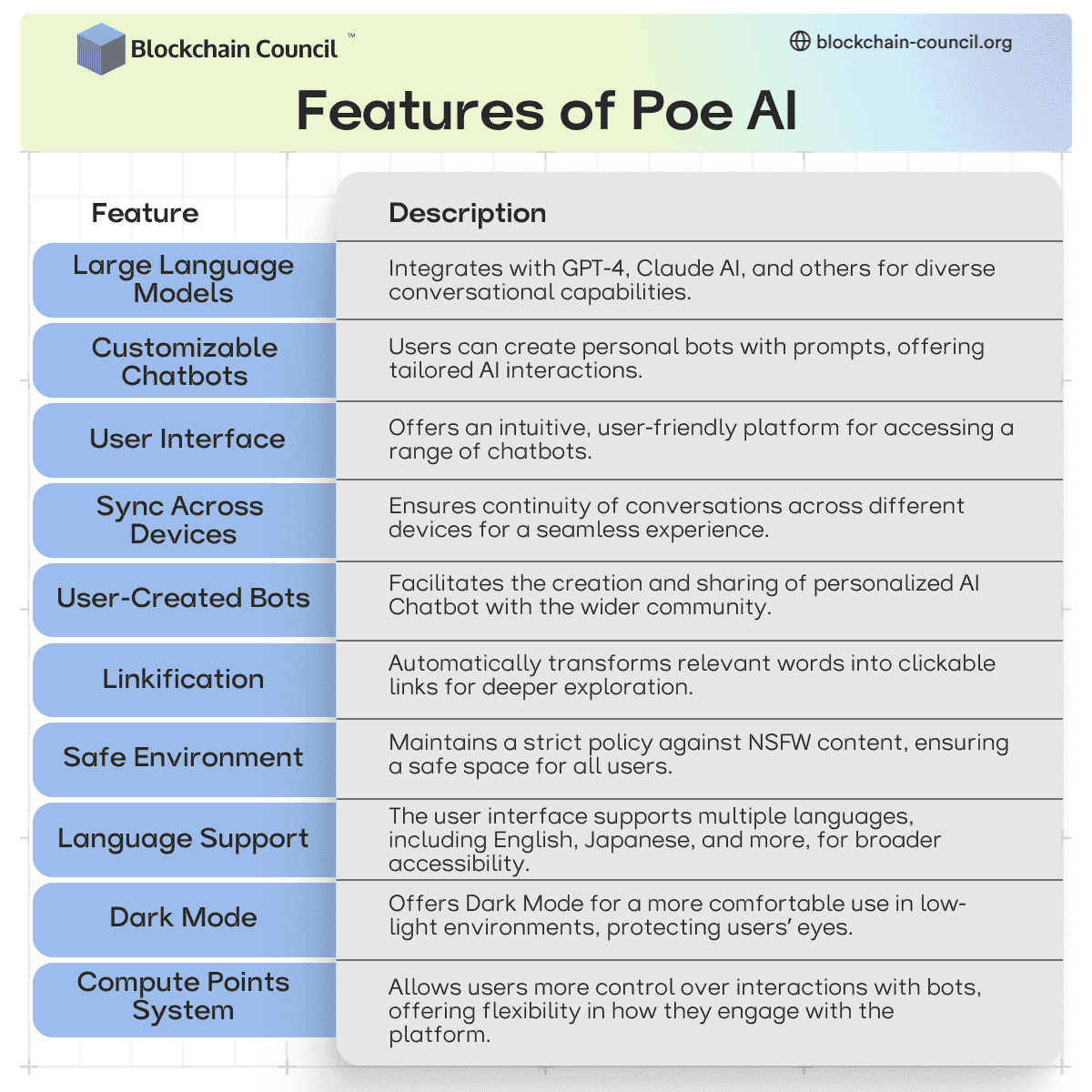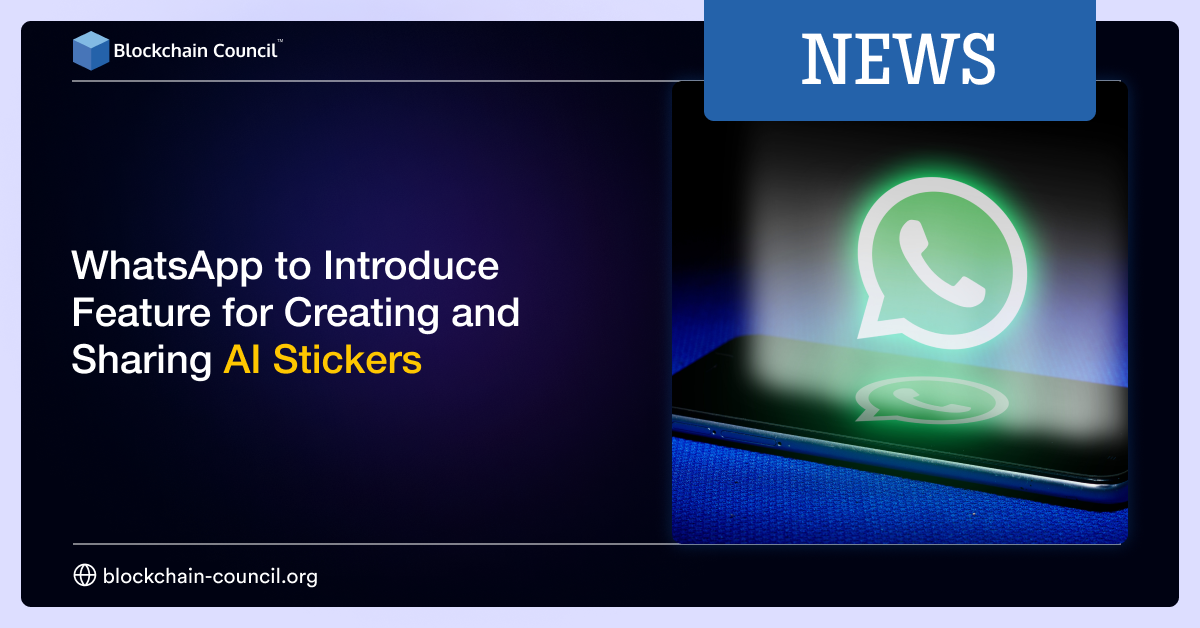
- Blockchain Council
- July 09, 2024
What is Poe AI?
POE stands for Platform for Open Exploration. It is a platform that allows users to ask questions, receive instant answers, and engage in conversations with various AI-powered bots. The significance of POE lies in its ability to provide access to different AI models from various sources, trained by different companies, optimized for different tasks, and offering diverse perspectives or knowledge.
Users can interact with models like ChatGPT, GPT-4, DALL-E 3 from OpenAI, Claude Instant and Claude 2 from Anthropic, StableDiffusionXL from Stability AI, PaLM and Gemini-Pro from Google, Llama 2 from Meta, Playground-v2 by Playground, Mistral-Medium by Mistral, among others. POE aims to be a platform for the collective exploration of new AI models and their possibilities as they are released, despite the imperfections of AI, which may lead to limitations in certain cases.
Also Read: Top 25 Artificial Intelligence Applications
Vision and Motivation Behind Poe’s Creation
Quora’s motivation to develop Poe AI stemmed from a vision to fill a noticeable gap in the AI chatbot domain. Prior to Poe’s introduction, users seeking to engage with different AI models had to navigate multiple platforms or interfaces, limiting the ease of exploration and interaction with various AI technologies. By consolidating access to several chatbots and LLMs, as well as uniquely customized bots, Poe AI serves as a hub for engaging, open-ended exploration of AI capabilities.
Quora, founded in 2009 by former Facebook employees Adam D’Angelo and Charlie Cheever, has always been driven by the mission to share and grow the world’s knowledge. With the launch of Poe, Quora aimed to extend its mission into the realm of AI, providing a platform that not only facilitates information sharing but also enhances it through the integration of various AI technologies.
This initiative reflects Quora’s acknowledgment of the growing importance of AI in everyday digital interactions and its potential to revolutionize the way we seek and process information. By creating a space where users can freely explore different AI models, Poe embodies Quora’s commitment to innovation, knowledge dissemination, and the democratization of AI technologies.
How Does Poe AI Work?
Poe AI operates as a versatile platform where users can interact with a wide array of AI chatbots. This platform hosts different bots, including those from OpenAI (such as ChatGPT and DALL-E 3), Anthropic (such as Claude 2), and others, providing a centralized hub for AI-driven interactions. Its architecture is designed to facilitate seamless access to various large language models (LLMs), enabling users to engage with multiple AI technologies in one place. By incorporating bots from leading AI developers, Poe ensures a rich, diverse experience for its users, catering to a broad spectrum of needs and interests, from casual conversations to more specialized queries. Notably, Poe enables users to create custom bots by combining text prompts with existing bots like Claude or ChatGPT as the base. These custom bots are hosted on Poe and have unique URLs. The platform offers a wide array of chatbots for diverse purposes, from tutoring to trip planning.
Interaction Process with AI Chatbots on Poe
Interacting with AI chatbots on Poe is designed to be straightforward and intuitive, ensuring users can easily navigate through the platform. The steps below outline the general process:
- Selecting a Chatbot: Users begin by selecting the AI chatbot they wish to interact with. Poe provides an easy-to-use interface where users can access a list of available AI chatbots. This selection can be made by clicking on options like “Your bots,” “Explore,” or the “start chat” icon within the Poe interface.
- Engaging in Conversation: Once a chatbot is selected, users are taken to a chat interface where they can begin their interaction. This interface allows for questions to be asked and requests to be made, with the AI responding accordingly. The interface remains consistent across different chatbots, though the responses will vary based on the selected AI.
- Switching Between Chatbots: Poe also offers the flexibility to switch between different chatbot conversations easily. A menu bar tracks all active and past conversations, enabling users to compare answers or revisit previous interactions without losing context.
- Creating Custom Bots: Beyond interacting with existing AI chatbots, Poe AI empowers users to create their own custom bots. This feature allows for personalization and innovation, as users can develop bots based on specific prompts or for unique purposes. The process involves signing into Poe, filling in the bot’s details, selecting a base bot, adding a prompt that defines the bot’s behavior, and finally creating the bot for use within the platform.
Also Read: What is Undetectable AI?
How Does Poe AI Determine Its Responses?
In Poe AI, machine learning plays a crucial role in training its language model. The platform’s AI models are trained on a massive amount of text data from various sources like the internet, books, articles, and more. This training process enables the AI to recognize patterns, understand language structures, and capture relationships between words and phrases. Poe AI utilizes a deep learning architecture called a transformer. Here is a simplified explanation of how it determines its responses:
- Training: Poe AI is trained on a vast amount of text data from various sources like the internet, books, and articles. During training, it learns to recognize patterns, understand language structures, and capture relationships between words and phrases.
- Neural Network Architecture: It is based on a deep learning architecture called a transformer, specifically GPT-3.5. This architecture consists of multiple layers of neural networks that process and analyze input text.
- Input and Output: When a user provides a prompt or question, the input text is processed by the neural network layers, allowing Poe to understand the context and meaning of the text.
- Contextual Understanding: Poe analyzes the input text, considering the surrounding context and word relationships to understand nuances and intentions behind the text.
- Response Generation: Based on the understanding of the input text, Poe generates a response by predicting the most likely sequence of words that would follow, considering patterns learned during training.
- Iterative Process: The response generation process is iterative, generating words one by one to ensure coherence and contextually appropriate responses.
- Fine-Tuning: Before deployment, Poe’s models undergo fine-tuning on specific datasets to enhance performance on certain tasks or domains.
While Poe AI strives to provide accurate responses, there may be instances where the generated content is inaccurate, biased, or incomplete. Users are encouraged to critically evaluate information provided and consult reliable sources for verification when needed.
Accessibility and Availability of Poe AI
Poe AI is a platform designed with accessibility in mind, aiming to support a wide range of users. It follows the Web Content Accessibility Guidelines (WCAG 2.0, Level AA) closely, which are standards set by the World Wide Web Consortium (W3C) to ensure digital content is accessible to everyone, including those with disabilities. This adherence to WCAG guidelines demonstrates Poe AI’s commitment to reducing barriers and expanding web equity, ensuring that all learners and users can reach their full potential in a universally accessible environment.
The platform is available on various devices, including iOS and Android, making it accessible to a wide audience. Users can download the apps from their respective stores, which allows for easy access to the service on the go. This wide device support ensures that Poe AI can reach a broad audience, catering to their needs for instant answers and AI-driven conversations regardless of the device they use.
Also Read: What is Perplexity AI?
Features of Poe AI
Conclusion
In conclusion, Poe AI represents a significant leap forward in the realm of artificial intelligence chatbots. Its dual role as an aggregator and a platform for creation places it at the forefront of AI interaction and development. The platform not only facilitates access to a broad spectrum of AI capabilities but also encourages user engagement and creativity through the development of custom bots. This fosters a vibrant community where knowledge, creativity, and innovation thrive. As Poe continues to evolve, it promises to expand the boundaries of AI chatbot technology, offering more sophisticated and personalized interactions.
FAQ’s
What types of AI chatbots are available on Poe AI?
- Poe AI hosts various AI chatbots, including ChatGPT, DALL-E 3, Claude, StableDiffusionXL, PaLM, Gemini-Pro, Llama 2, and more.
- These chatbots cater to different needs such as entertainment, learning, language learning, academic tutoring, and more.
- Users can explore a wide array of bots designed for different purposes and interests.
How can I interact with AI chatbots on Poe AI?
- Interacting with AI chatbots on Poe AI is simple and intuitive.
- Users can select a chatbot from the list provided in the interface by clicking on options like “Your bots,” “Explore,” or the “start chat” icon.
- Once selected, users can engage in conversation by asking questions or making requests within the chat interface.
- Poe AI also allows users to switch between different chatbots easily using the menu bar to track active and past conversations.
Can I create my own custom bots on Poe AI?
- Yes, Poe AI empowers users to create their own custom bots.
- Users can personalize their bots by combining text prompts with existing bots like Claude or ChatGPT as the base.
- The process involves signing into Poe, filling in the bot’s details, selecting a base bot, adding a prompt that defines the bot’s behavior, and creating the bot for use within the platform.
- This feature enables users to innovate and develop bots tailored to their specific needs or interests.
How does Poe AI determine its responses?
- Poe AI utilizes a deep learning architecture called a transformer, specifically GPT-3.5, to determine its responses.
- The platform’s AI models are trained on a massive amount of text data from various sources such as the internet, books, and articles.
- During training, the AI learns to recognize patterns, understand language structures, and capture relationships between words and phrases.
- When a user provides a prompt or question, the input text is processed by the neural network layers, allowing Poe to understand the context and generate a response based on learned patterns and contextual understanding.






































































 Guides
Guides News
News Blockchain
Blockchain Cryptocurrency
& Digital Assets
Cryptocurrency
& Digital Assets Web3
Web3 Metaverse & NFTs
Metaverse & NFTs
